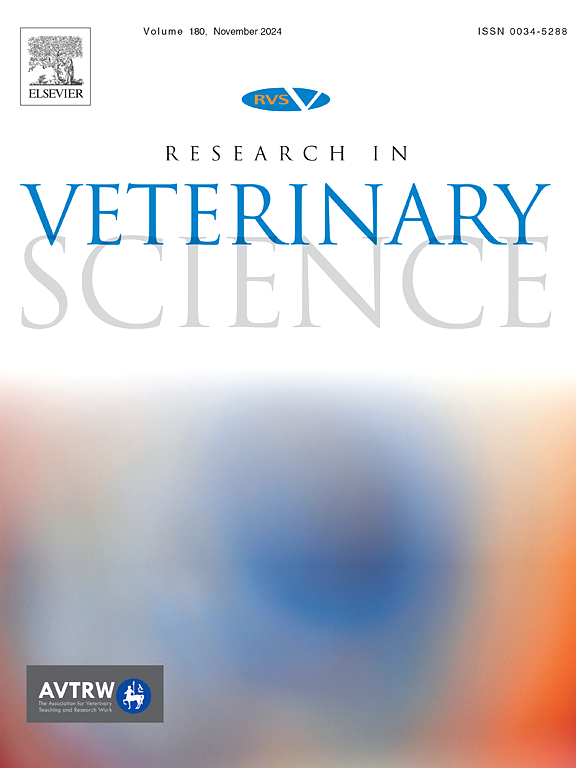Cytauxzoon europaeus, Babesia vulpes, and Hepatozoon felis circulating simultaneously in a European wildcat (Felis silvestris) population in northern Spain
IF 2.2
3区 农林科学
Q1 VETERINARY SCIENCES
引用次数: 0
Abstract
The Iberian population of the European wildcat (Felis silvestris) is undergoing a decline and is highly fragmented. This study aimed to determine the occurrence and identity of tick-borne parasites (piroplasms and Hepatozoon spp.) in Navarre, one of the strongholds for wildcats in Spain. DNA was extracted from spleen samples of 63 road-killed wildcats and analyzed using a suite of molecular protocols targeting the 18S rRNA and CytB gene fragments. Eighty percent of the wildcats tested positive for at least one parasite. Cytauxzoon spp. was detected in 65 % of the individuals. Molecular characterization and phylogenetic analysis confirmed the presence of Cytauxzoon europaeus in nine samples, representing the first report of this species in the Iberian Peninsula. Hepatozoon spp. was found in 46 % of the wildcats, and molecular characterization of four cases identified Hepatozoon felis. Babesia vulpes was detected in a single individual. Coinfection with Cytauxzoon sp. and Hepatozoon sp. was observed in 32 % of the wildcats, while one individual was coinfected with C. europaeus and B. vulpes. Occurrence of H. felis was higher in adult wildcats. No spatial structure or correlation with body condition was observed for any of the parasites. Given the widespread presence of Cytauxzoon and other parasites in this and other wildcat populations, their impact on wildcat health, if any, is likely to be minimal. However, wildcats appear to serve as important maintenance hosts for these parasites.
在西班牙北部的欧洲野猫(felis silvestris)种群中,欧洲巴贝斯虫、秃鹫巴贝斯虫和猫科动物肝虫同时传播
欧洲野猫(Felis silvestris)在伊比利亚的种群数量正在下降,并且高度分散。本研究旨在确定纳瓦拉(西班牙野猫的大本营之一)蜱传寄生虫(梨形虫和肝虫)的发生和鉴定。从63只公路死亡野猫的脾脏样本中提取DNA,并使用一套针对18S rRNA和CytB基因片段的分子协议进行分析。80%的野猫至少有一种寄生虫检测呈阳性。65%的个体检出Cytauxzoon。分子鉴定和系统发育分析证实9份样本中存在europaeus细胞株,为该物种在伊比利亚半岛的首次报道。在46%的野猫中发现肝zoon,在4例野猫中鉴定出felis肝zoon。在单个个体中检测到巴贝斯虫。32%的野猫同时感染了细胞原虫和肝原虫,1只野猫同时感染了欧洲棘球蚴和秃鹫棘球蚴。成年野猫中猫毛杆菌的发生率较高。没有观察到任何寄生虫的空间结构或与身体状况的相关性。鉴于Cytauxzoon和其他寄生虫在这个和其他野猫种群中的广泛存在,它们对野猫健康的影响,如果有的话,可能是微乎其微的。然而,野猫似乎是这些寄生虫重要的维持宿主。
本文章由计算机程序翻译,如有差异,请以英文原文为准。
求助全文
约1分钟内获得全文
求助全文
来源期刊

Research in veterinary science
农林科学-兽医学
CiteScore
4.40
自引率
4.20%
发文量
312
审稿时长
75 days
期刊介绍:
Research in Veterinary Science is an International multi-disciplinary journal publishing original articles, reviews and short communications of a high scientific and ethical standard in all aspects of veterinary and biomedical research.
The primary aim of the journal is to inform veterinary and biomedical scientists of significant advances in veterinary and related research through prompt publication and dissemination. Secondly, the journal aims to provide a general multi-disciplinary forum for discussion and debate of news and issues concerning veterinary science. Thirdly, to promote the dissemination of knowledge to a broader range of professions, globally.
High quality papers on all species of animals are considered, particularly those considered to be of high scientific importance and originality, and with interdisciplinary interest. The journal encourages papers providing results that have clear implications for understanding disease pathogenesis and for the development of control measures or treatments, as well as those dealing with a comparative biomedical approach, which represents a substantial improvement to animal and human health.
Studies without a robust scientific hypothesis or that are preliminary, or of weak originality, as well as negative results, are not appropriate for the journal. Furthermore, observational approaches, case studies or field reports lacking an advancement in general knowledge do not fall within the scope of the journal.
 求助内容:
求助内容: 应助结果提醒方式:
应助结果提醒方式:


